Laminar diversity of dynamic sound processing in cat primary auditory cortex
- PMID: 19864440
- PMCID: PMC2807218
- DOI: 10.1152/jn.00624.2009
Laminar diversity of dynamic sound processing in cat primary auditory cortex
Abstract
For primary auditory cortex (AI) laminae, there is little evidence of functional specificity despite clearly expressed cellular and connectional differences. Natural sounds are dominated by dynamic temporal and spectral modulations and we used these properties to evaluate local functional differences or constancies across laminae. To examine the layer-specific processing of acoustic modulation information, we simultaneously recorded from multiple AI laminae in the anesthetized cat. Neurons were challenged with dynamic moving ripple stimuli and we subsequently computed spectrotemporal receptive fields (STRFs). From the STRFs, temporal and spectral modulation transfer functions (tMTFs, sMTFs) were calculated and compared across layers. Temporal and spectral modulation properties often differed between layers. On average, layer II/III and VI neurons responded to lower temporal modulations than those in layer IV. tMTFs were mainly band-pass in granular layer IV and became more low-pass in infragranular layers. Compared with layer IV, spectral MTFs were broader and their upper cutoff frequencies higher in layers V and VI. In individual penetrations, temporal modulation preference was similar across layers for roughly 70% of the penetrations, suggesting a common, columnar functional characteristic. By contrast, only about 30% of penetrations showed consistent spectral modulation preferences across layers, indicative of functional laminar diversity or specialization. Since local laminar differences in stimulus preference do not always parallel the main flow of information in the columnar cortical microcircuit, this indicates the influence of additional horizontal or thalamocortical inputs. AI layers that express differing modulation properties may serve distinct roles in the extraction of dynamic sound information, with the differing information specific to the targeted stations of each layer.
Figures

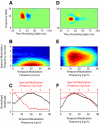
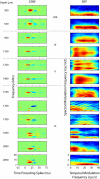
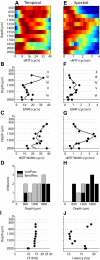
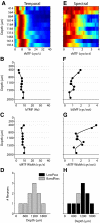


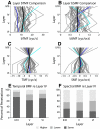

References
-
- Abeles M, Goldstein MH., Jr Functional architecture in cat primary auditory cortex: columnar organization and organization according to depth. J Neurophysiol 33: 172–187, 1970 - PubMed
-
- Adams DL, Horton JC. Capricious expression of cortical columns in the primate brain. Nat Neurosci 6: 113–114, 2003 - PubMed
-
- Aertsen A, Johannesma PI. Spectro-temporal receptive fields of auditory neurons in the grassfrog. I. Characterization of tonal and natural stimuli. Biol Cybern 38: 223–234, 1980 - PubMed
-
- Ahissar E, Sosnik R, Bagdasarian K, Haidarliu S. Temporal frequency of whisker movement. II. Laminar organization of cortical representations. J Neurophysiol 86: 354–367, 2001 - PubMed
Publication types
MeSH terms
Grants and funding
LinkOut - more resources
Full Text Sources
Miscellaneous

